You could do this:
>>> import numpy as np
>>> a=.1
>>> b=np.nextafter(1,2)
>>> print(b)
1.0000000000000002
>>> [a+(b-a)*random.random() for i in range(10)]
or, use numpy's uniform:
np.random.uniform(low=0.1, high=np.nextafter(1,2), size=1)
nextafter will produce the platform specific next representable floating pointing number towards a direction. Using numpy's random.uniform is advantageous because it is unambiguous that it does not include the upper bound.
Edit
It does appear that Mark Dickinson's comments is correct: Numpy's documentation is incorrect regarding the upper bound to random.uniform being inclusive or not.
The Numpy documentation states All values generated will be less than high.
This is easily disproved:
>>> low=1.0
>>> high=1.0+2**-49
>>> a=np.random.uniform(low=low, high=high, size=10000)
>>> len(np.where(a==high)[0])
640
Nor is the result uniform over this limited range:
>>> for e in sorted(set(a)):
... print('{:.16e}: {}'.format(e,len(np.where(a==e)[0])))
...
1.0000000000000000e+00: 652
1.0000000000000002e+00: 1215
1.0000000000000004e+00: 1249
1.0000000000000007e+00: 1288
1.0000000000000009e+00: 1245
1.0000000000000011e+00: 1241
1.0000000000000013e+00: 1228
1.0000000000000016e+00: 1242
1.0000000000000018e+00: 640
However, combining J.F. Sebastian and Mark Dickinson's comments, I think this works:
import numpy as np
import random
def rand_range(low=0,high=1,size=1):
a=np.nextafter(low,float('-inf'))
b=np.nextafter(high,float('inf'))
def r():
def rn():
return a+(b-a)*random.random()
_rtr=rn()
while _rtr > high:
_rtr=rn()
if _rtr<low:
_rtr=low
return _rtr
return [r() for i in range(size)]
If run with the minimal spread of values in Mark's comment such that there are very few discrete floating point values:
l,h=1,1+2**-48
s=10000
rands=rand_range(l,h,s)
se=sorted(set(rands))
if len(se)<25:
for i,e in enumerate(se,1):
c=rands.count(e)
note=''
if e==l: note='low value end point'
if e==h: note='high value end point'
print ('{:>2} {:.16e} {:,}, {:.4%} {}'.format(i, e, c, c/s,note))
It produces the desired uniform distribution inclusive of end points:
1 1.0000000000000000e+00 589, 5.8900% low value end point
2 1.0000000000000002e+00 544, 5.4400%
3 1.0000000000000004e+00 612, 6.1200%
4 1.0000000000000007e+00 569, 5.6900%
5 1.0000000000000009e+00 593, 5.9300%
6 1.0000000000000011e+00 580, 5.8000%
7 1.0000000000000013e+00 565, 5.6500%
8 1.0000000000000016e+00 584, 5.8400%
9 1.0000000000000018e+00 603, 6.0300%
10 1.0000000000000020e+00 589, 5.8900%
11 1.0000000000000022e+00 597, 5.9700%
12 1.0000000000000024e+00 591, 5.9100%
13 1.0000000000000027e+00 572, 5.7200%
14 1.0000000000000029e+00 619, 6.1900%
15 1.0000000000000031e+00 593, 5.9300%
16 1.0000000000000033e+00 592, 5.9200%
17 1.0000000000000036e+00 608, 6.0800% high value end point
On the values requested by the OP, it also produces a uniform distribution:
import matplotlib.pyplot as plt
l,h=.1,1
s=10000
bin_count=20
rands=rand_range(l,h,s)
count, bins, ignored = plt.hist(np.array(rands),bin_count)
plt.plot(bins, np.ones_like(bins)*s/bin_count, linewidth=2, color='r')
plt.show()
Output

